Evaluation of the Main Function of Low Impact Development Based on Rainfall Events
Abstract
1. Introduction
2. Materials and Methods
2.1. Study Area Description
2.2. SWMM
2.3. Simulation Scenarios
2.4. Design Rainfall
2.5. Input Parameters of SWMM-LIDs
3. Results and Discussion
3.1. Calibration and Validation
3.2. Sensitivity Analysis
3.3. Hydrological Balance Analysis
3.3.1. Variation in Infiltration
3.3.2. Variation in Surface Runoff
3.4. Runoff Reduction Analysis
3.4.1. Peak Flow Reduction
3.4.2. Total Volume Reduction
4. Conclusions
Author Contributions
Funding
Conflicts of Interest
References
- Newcomer, M.E.; Gurdak, J.J.; Sklar, L.S.; Nanus, L. Urban recharge beneath low impact development and effects of climate variability and change. Water Resour. Res. 2014, 50, 1716–1734. [Google Scholar] [CrossRef]
- Zhou, Q. A Review of Sustainable Urban Drainage Systems Considering the Climate Change and Urbanization Impacts. Water 2014, 6, 976–992. [Google Scholar] [CrossRef]
- Liu, Y.; Bralts, V.F.; Engel, B. Evaluating the effectiveness of management practices on hydrology and water quality at watershed scale with a rainfall-runoff model. Sci. Total Environ. 2015, 511, 298–308. [Google Scholar] [CrossRef] [PubMed]
- Seo, M.; Jaber, F.; Srinivasan, R.; Jeong, J. Evaluating the Impact of Low Impact Development (LID) Practices on Water Quantity and Quality under Different Development Designs Using SWAT. Water 2017, 9, 193. [Google Scholar] [CrossRef]
- Satterthwaite, D. The implications of population growth and urbanization for climate change. Environ. Urban. 2009, 21, 545–567. [Google Scholar] [CrossRef]
- Ahiablame, L.M.; Engel, B.A.; Chaubey, I. Effectiveness of low impact development practices in two urbanized watersheds: Retrofitting with rain barrel/cistern and porous pavement. J. Environ. Manag. 2013, 119, 151–161. [Google Scholar] [CrossRef]
- Fayetteville, A. LID Low Impact Development: A design Manual for Urban Areas; University of Arkansas Community Design Center: Fayetteville, AR, USA, 2011. [Google Scholar]
- Li, C.; Liu, M.; Hu, Y.; Han, R.; Shi, T.; Qu, X.; Wu, Y. Evaluating the Hydrologic Performance of Low Impact Development Scenarios in a Micro Urban Catchment. Int. J. Environ. Res. Public Health 2018, 15, 273. [Google Scholar] [CrossRef]
- Lee, D.C. Restoration of Water Cycle by a Rainwater Management System Applied to Low Impact Development (LID). Ecol. Resilient Infrastruct. 2016, 3, 130–133. [Google Scholar] [CrossRef][Green Version]
- Martin-Mikle, C.J.; De Beurs, K.M.; Julian, J.P.; Mayer, P. Identifying priority sites for low impact development (LID) in a mixed-use watershed. Landsc. Urban Plan. 2015, 140, 29–41. [Google Scholar] [CrossRef]
- Goncalves, M.L.R.; Zischg, J.; Rau, S.; Sitzmann, M.; Rauch, W.; Kleidorfer, M. Modeling the Effects of Introducing Low Impact Development in a Tropical City: A Case Study from Joinville, Brazil. Sustainability 2018, 10, 728. [Google Scholar] [CrossRef]
- Wu, J.; Yang, R.; Song, J. Effectiveness of low impact development for urban inundation risk mitigation under different scenarios: A case study in Shenzhen, China. Nat. Hazards Earth Syst. Sci. 2018, 18, 2525–2536. [Google Scholar] [CrossRef]
- Luan, Q.; Fu, X.; Song, C.; Wang, H.; Liu, J.; Wang, Y. Runoff Effect Evaluation of LID through SWMM in Typical Mountainous, Low-Lying Urban Areas: A Case Study in China. Water 2017, 9, 439. [Google Scholar] [CrossRef]
- Gilroy, K.L.; McCuen, R.H. Spatio-temporal effects of low impact development practices. J. Hydrol. 2009, 367, 228–236. [Google Scholar] [CrossRef]
- Kong, F.; Ban, Y.; Yin, H.; James, P.; Dronova, I. Modeling stormwater management at the city district level in response to changes in land use and low impact development. Environ. Model. Softw. 2017, 95, 132–142. [Google Scholar] [CrossRef]
- Zhu, Z.; Chen, X. Evaluating the Effects of Low Impact Development Practices on Urban Flooding under Different Rainfall Intensities. Water 2017, 9, 548. [Google Scholar] [CrossRef]
- Qin, H.; Li, Z.-X.; Fu, G. The effects of low impact development on urban flooding under different rainfall characteristics. J. Environ. Manag. 2013, 129, 577–585. [Google Scholar] [CrossRef]
- Koo, Y.M.; Seo, D.G. Parameter estimations to improve urban planning area runoff prediction accuracy using Stormwater Management Model (SWMM). J. Korea Water Res. Assoc. 2017, 50, 303–313. [Google Scholar]
- Chen, C.-F.; Sheng, M.-Y.; Chang, C.-L.; Kang, S.-F.; Lin, J.-Y. Application of the SUSTAIN Model to a Watershed-Scale Case for Water Quality Management. Water 2014, 6, 3575–3589. [Google Scholar] [CrossRef]
- Fleischmann, C.M. Evaluating Management Strategies for Urban Stormwater Runoff. Ph.D. Thesis, University of Connecticut, Storrs, CT, USA, 2014. [Google Scholar]
- Rossman, L.A. Storm Water Management Model User’s Manual; US EPA Office of Research and Development: Washington, DC, USA, 2015.
- Rawls, W.J.; Brakensiek, D.L.; Miller, N. Green-ampt Infiltration Parameters from Soils Data. J. Hydraul. Eng. 1983, 109, 62–70. [Google Scholar] [CrossRef]
- Hangzhou Municipal Commission of Urban-Rural Development. Construction Guidelines of Sponge City in Hangzhou. 2016. Available online: http://cxjw.hangzhou.gov.cn/art/2016/10/19/art_1228985153_38649182.html (accessed on 19 October 2018). (In Chinese)
- IPCC (Intergovernmental Panel on Climate Change). Mitigation of Climate Change—Summary for Policymakers and Technical Summary 2014; Climate Change 2014. Available online: https://www.ipcc.ch/report/ar5/wg3/ (accessed on 9 August 2018).
- Predrag, P.; Slobodan, P.S. Generation of Synthetic Design Storms for the Upper Thames River Basin. Water Resources Research Report 2004. p. 15. Available online: https://ir.lib.uwo.ca/wrrr/15 (accessed on 9 August 2018).
- Lee, E.H.; Kim, J.H. Development of a flood-damage-based flood forecasting technique. J. Hydrol. 2018, 563, 181–194. [Google Scholar] [CrossRef]
- Ahn, J.; Cho, W.; Kim, T.; Shin, H.; Heo, J. Flood Frequency Analysis for the Annual Peak Flows Simulated by an Event-Based Rainfall-Runoff Model in an Urban Drainage Basin. Water 2014, 6, 3841–3863. [Google Scholar] [CrossRef]
- Korea Precipitation Frequency Data Server. Available online: www.k-idf.re.kr (accessed on 11 August 2018).
- Ministry of Housing and Urban-Rural Development (MOHURD). Sponge City Construction Technical Guidelines—Construction of Low impact Development Stormwater System. 2014. Available online: http://www.mohurd.gov.cn/wjfb/201411/t20141102_219465.html (accessed on 13 October 2018). (In Chinese)
- Waseem, M.; Mani, N.; Andiego, G.; Usman, M. A review of criteria of fit for hydrological models. Int. Res. J. Eng. Technol. 2017, 4, 1765–1772. [Google Scholar]
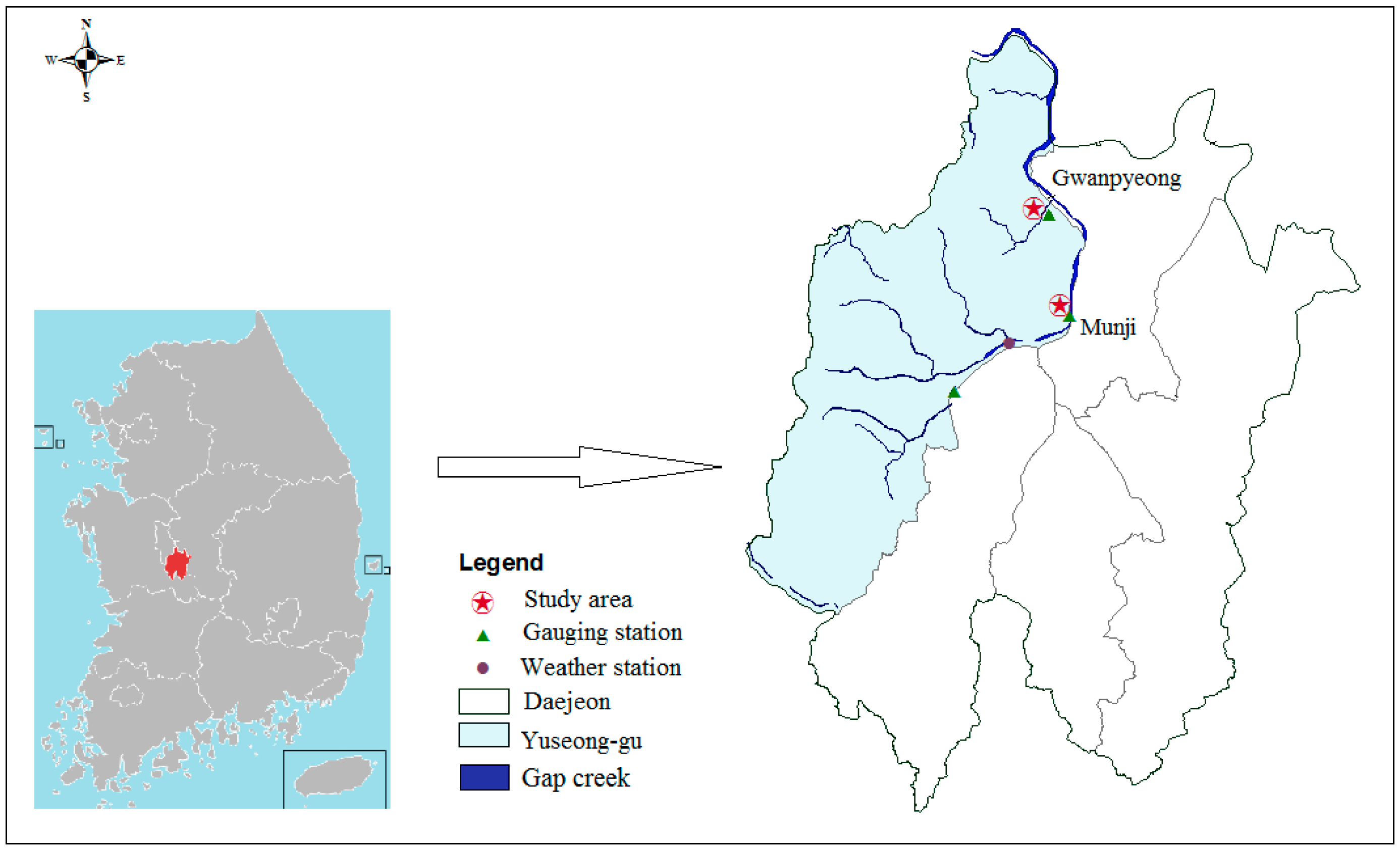
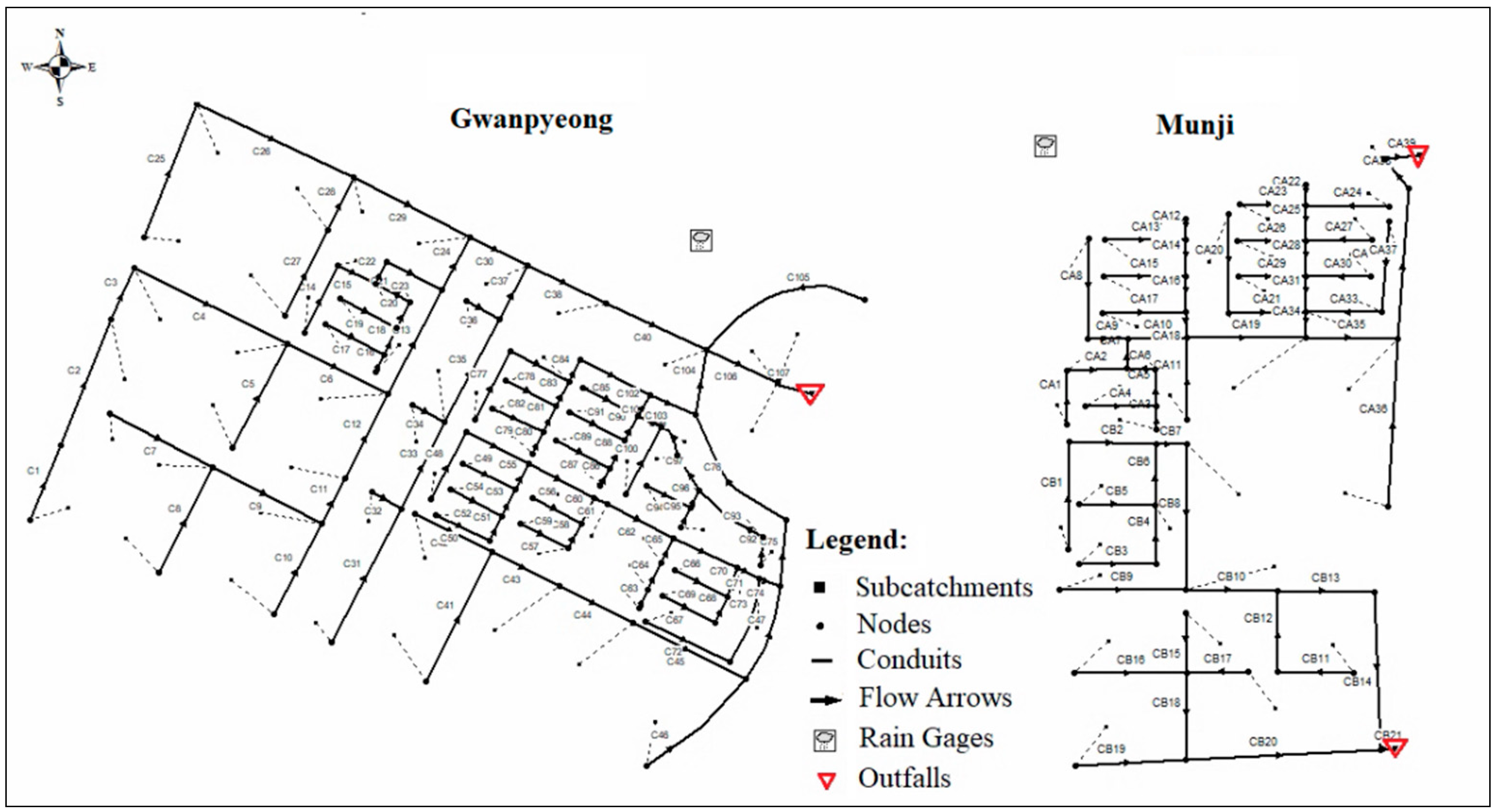



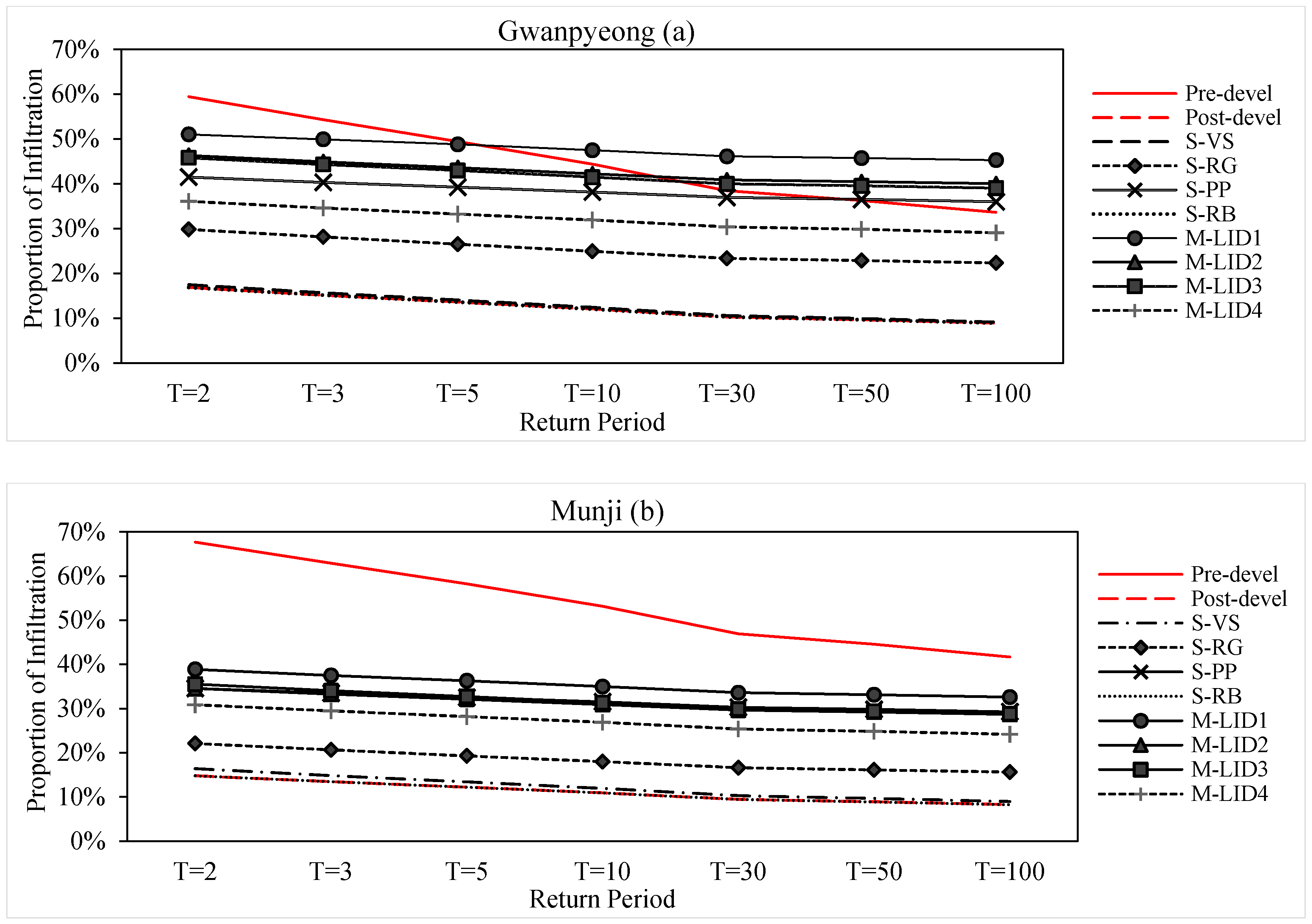
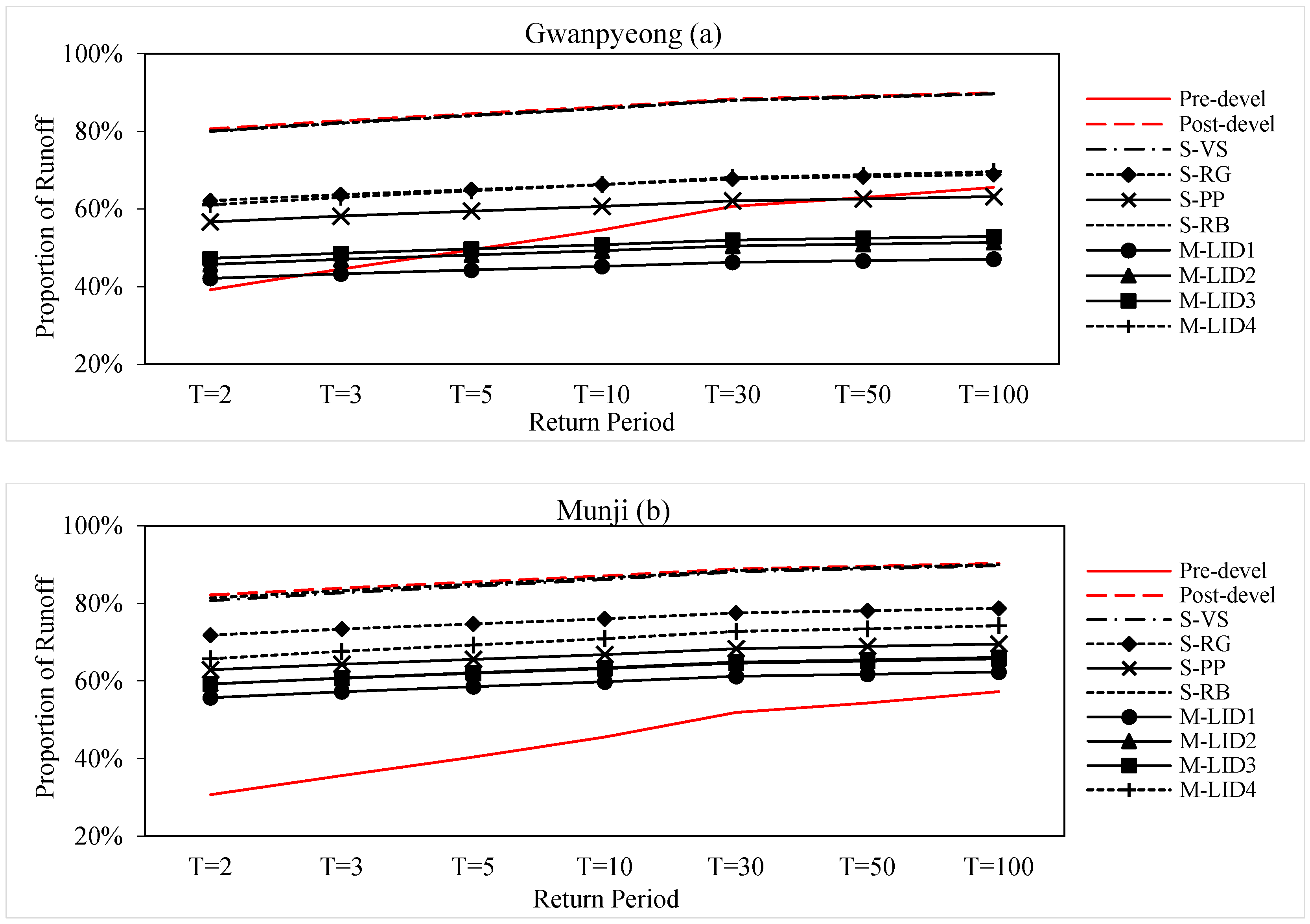
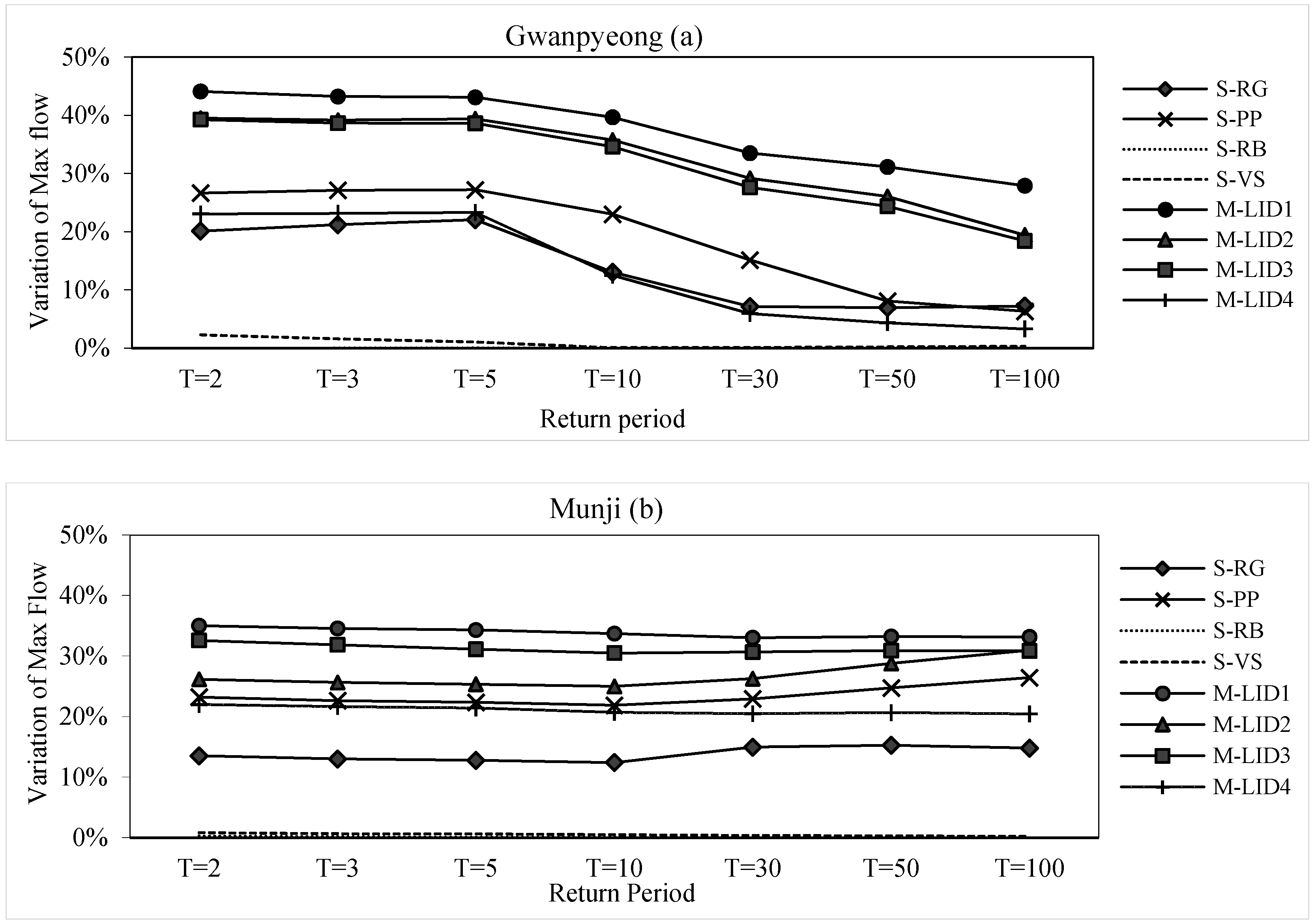

| LID Scenarios | Gwanpyeong Region | Munji Region | |
|---|---|---|---|
| S-RG | S-RG | 16.5% | 9.1% |
| S-PP | S-PP | 21.3% | 13.3% |
| S-RB | S-RB | 349 (number) | 197 (number) |
| S-VS | S-VS | 5.3% | 7.1% |
| RG + PP + RB + VS | M-LID1 | 43.1% 1 | 29.4% 1 |
| 50% PP + RB + RG | M-LID2 | 27.1% 1 | 15.7% 1 |
| 50% PP + RG + VS | M-LID3 | 32.4% | 22.8% |
| 50% PP + RB + VS | M-LID4 | 15.9% 1 | 13.8% 1 |
| Return Period | Storm Duration | |||||||
|---|---|---|---|---|---|---|---|---|
| 10 min | 20 min | 30 min | 40 min | 50 min | 60 min | 90 min | 120 min | |
| 2 years | 15.5 | 24.3 | 30.3 | 35.7 | 39.9 | 44.2 | 53.2 | 59.4 |
| 3 years | 17.7 | 27.7 | 34.5 | 40.5 | 45.3 | 50.9 | 61.9 | 68.8 |
| 5 years | 20.3 | 31.5 | 39.2 | 45.8 | 51.4 | 58.4 | 71.6 | 79.2 |
| 10 years | 23.5 | 36.3 | 45.1 | 52.6 | 59 | 67.8 | 83.8 | 92.4 |
| 30 years | 28.4 | 43.6 | 53.9 | 62.7 | 70.6 | 82 | 102.2 | 112.2 |
| 50 years | 30.6 | 46.9 | 58 | 67.4 | 75.8 | 88.4 | 110.6 | 121.3 |
| 100 years | 33.6 | 51.3 | 63.4 | 73.6 | 82.9 | 97.2 | 122 | 133.5 |
| Simulation Options | Unit | Value | Source |
|---|---|---|---|
| N-Impervious | 0.015 | Calibration and Validation | |
| N-Pervious | 0.55 | Calibration and Validation | |
| Pipe Roughness | 0.013–0.015 | Calibration and Validation | |
| Dstore-Impervious | mm | 1.35 | Calibration and Validation |
| Dstore-Pervious | mm | 1 | Calibration and Validation |
| Soil Capillary Suction Head | mm | 88.9 | SWMM User Manual |
| Soil Hydraulic Conductivity | mm/h | 3.3 | SWMM User Manual |
| % Zero-Imperv | % | 25 | SWMM User Manual |
| Scenarios | Events | Rainfall (mm) | Duration (h) | NSE | |
|---|---|---|---|---|---|
| R1 | 13.11.2015. 10:00–22:00 | 25.8 | 12 | 0.84 | 0.90 |
| R2 | 16.4.2016 17:30–17.4.2016.10:00 | 48.4 | 16.5 | 0.82 | 0.95 |
| R3 | 09.8.2017. 3:50–10.8.2017. 3:50 | 59.8 | 24 | 0.91 | 0.93 |
| R4 | 21.08.2017. 7:00–22:10 | 15.8 | 15.2 | 0.80 | 0.85 |
| R5 | 21.7.2015 20:40–25.7.2015. 5:30 | 93.6 | 80.9 | 0.76 | 0.73 |
© 2020 by the authors. Licensee MDPI, Basel, Switzerland. This article is an open access article distributed under the terms and conditions of the Creative Commons Attribution (CC BY) license (http://creativecommons.org/licenses/by/4.0/).
Share and Cite
Feng, M.; Jung, K.; Li, F.; Li, H.; Kim, J.-C. Evaluation of the Main Function of Low Impact Development Based on Rainfall Events. Water 2020, 12, 2231. https://doi.org/10.3390/w12082231
Feng M, Jung K, Li F, Li H, Kim J-C. Evaluation of the Main Function of Low Impact Development Based on Rainfall Events. Water. 2020; 12(8):2231. https://doi.org/10.3390/w12082231
Chicago/Turabian StyleFeng, Meiyan, Kwansue Jung, Fengping Li, Hongyan Li, and Joo-Cheol Kim. 2020. "Evaluation of the Main Function of Low Impact Development Based on Rainfall Events" Water 12, no. 8: 2231. https://doi.org/10.3390/w12082231
APA StyleFeng, M., Jung, K., Li, F., Li, H., & Kim, J.-C. (2020). Evaluation of the Main Function of Low Impact Development Based on Rainfall Events. Water, 12(8), 2231. https://doi.org/10.3390/w12082231




